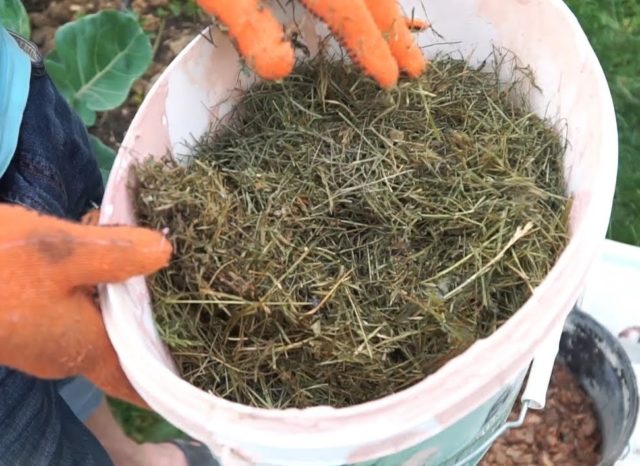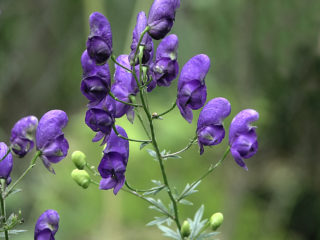Content
Carmichel's aconite is a beautiful perennial shrub with blue-white flowers collected in dense inflorescences. It is distinguished by its unpretentiousness and high winter hardiness, which allows it to be successfully grown in most regions of Russia.
Description of Carmichel Arendsy's aconite
Aconitum carmichaelii Arendsi is a perennial flowering shrub of small height up to 80-100 cm from the Ranunculaceae family. The branches are straight and compactly arranged. The leaves are grassy green. Aconite begins to bloom in the first half of July (until the beginning of September). Flowers form elongated inflorescences (up to 60 cm). Arends' aconite (pictured) has bicolor petals in shades of blue and white.

Carmichel's aconite decorates the garden with original, brightly colored flowers
The plant is winter-hardy: aconite can withstand frosts down to -40 °C. Therefore, it can be bred in almost any region of Russia - the Central part, the Urals, Siberia, the Far East.
Application in landscape design
Carmichel's aconite looks good both in single and group plantings. It is combined with different flowers and ornamental plants:
- irises;
- astilbe;
- peonies;
- yarrows;
- daylilies.
When composing compositions, pay attention to the combination of heights and colors (blue shades of aconite harmonize best with the yellow inflorescences of other crops).
The plant looks beautiful in mixborders, simple and complex flower beds, and in single plantings on well-groomed lawns.

Aconite is suitable for growing in above-ground flowerpots and plant pots
The culture is used for vertical gardening of fences, canopies, gazebos and other structures.

Wolfsbane goes especially well with orange and yellow flowers
The plant can be used for landscaping the far corners of the garden.

Arends' aconite also harmonizes with white plants
Features of reproduction
Carmichel's aconite can be propagated:
- seeds;
- cuttings;
- tubers;
- dividing the bush.
The first method is the most labor-intensive, so it is not used often. Seeds are initially sown before winter or stratified in the refrigerator to imitate natural conditions. In this case, flowering will begin no earlier than 2-3 years.
It is very easy to propagate Carmichel aconite from cuttings. To do this, in May, several green shoots are cut and planted in open ground under film or agrofibre. After a few weeks, the plant will take root, after which it is transplanted to a permanent place.
You can dilute aconite with tubers in early September: put 2-3 pieces in a hole, bury them, water them and leave them for the winter.The bush should be divided in the spring, preferably once every 4 years. It is dug out with a sharp shovel and then divided into several sections with a knife. Each of them is buried in soil to a shallow depth of 3 cm and watered abundantly.
Planting and care
Carmichel's aconite is an unpretentious plant that takes root well in almost any soil, except for heavy rocky and sandy soils, as well as waterlogged, swampy soils.
Recommended timing
It is optimal to plant aconite seedlings in the spring, when the soil has already warmed up quite well - in most regions this is mid-May. In the south it is allowed to plant the plant at the end of April. There is another deadline - mid-September, about a month before the onset of the first frost.
Site selection and soil preparation
There are no special requirements for a place to plant the plant, since Carmichel aconite feels good both in an open area and in the shade of trees. It is advisable to place it on a hill, and not in a lowland, where moisture constantly accumulates. If possible, the place should be protected from open winds.
Since the plant is poisonous, it is extremely important that the planting site is not accessible to children or pets. The area is pre-cleaned and dug up, and complex mineral fertilizer is applied in an amount of 50-60 g per m2.
Landing algorithm
The sequence of actions when planting Carmichel aconite is as follows:
- Inspect the seedlings and remove all damaged roots.
- Prepare several holes at a distance of 60-70 cm (depth and width should correspond to the size of the roots).
- Place a drainage layer on the bottom - small stones, pebbles, broken bricks.
- Install the seedlings, sprinkle with soil mixed with a few pinches of sand, and tamp lightly.
- Water generously and mulch with peat, humus, pine needles, and straw.
Watering and fertilizing schedule
Carmichel aconite is a drought-resistant plant. However, it needs regular watering. The soil should not be too waterlogged, and at the same time, cracking of the surface layer is unacceptable. Therefore, during the dry season in summer, you can water 2-3 times a month. If precipitation is heavy, the plant does not need additional moisture.
If fertilizers were applied to the site or to the planting hole, then in the first season there is no need to feed Carmichel aconite. Next year, at the end of spring, you can add compost, and at the end of June (before flowering) - complex mineral fertilizer. There is no need to feed anything else.
Loosening, mulching
The roots need a constant flow of air, so periodically you need to loosen the surface layer of soil. This is especially important during fertilizing and watering. You need to mulch the roots immediately after planting - for example, peat, humus, straw. Thanks to this, the soil will retain moisture longer. In addition, a layer of mulch will prevent the development of weeds.
Care during the flowering period
During flowering, Carmichel's aconite needs more attention. It is necessary to monitor watering - the surface layer of soil should always remain slightly moist.Experienced gardeners also advise immediately removing fading inflorescences. The cut area can be treated in a weak solution of potassium permanganate. Thanks to this, the growth of other flowers is activated - as a result, flowering will last longer and be more luxuriant.
Preparing for winter
Despite its good winter hardiness, Carmichel aconite begins to be prepared for the cold period in the fall. To do this, the plant is completely cut off, leaving shoots 4-5 cm high. Then it is covered with dry peat, foliage, and spruce branches. In March, this shelter is removed so that the soil has time to dry.
Pests and diseases
Carmichel's aconite has good immunity. However, it can suffer from pests and diseases, the appearance of which is often associated with care (insufficient or excessive watering, applying large amounts of fertilizer). Due to violation of the rules of agricultural technology, powdery mildew settles on the plant. The main signs are wilting stems and leaves.
In this case, it is necessary to remove all affected shoots and treat aconite with any fungicide:
- Bordeaux mixture;
- "Fundazol";
- "Maksim";
- "Acrobat";
- "Skor";
- "Tattu."
Another disease of aconite is associated with a viral infection, due to which the flowers begin to turn green and become deformed. The carriers of the pathogen are insects (ticks, aphids and others). In addition, nematodes periodically parasitize the bushes. You can cope with these pests using insecticides:
- "Aktara";
- "Karbofos";
- "Karate";
- "Mercaptophos";
- "Phosfamide" and others.
You can also control insects with home remedies. To do this, use a solution of baking soda, ammonia, laundry soap shavings, infusion of garlic, onion peels and other recipes.
Conclusion
Carmichel's aconite is one of the most beautiful flowering shrubs, attracting attention with its original blue flowers. It is very easy to grow this flower in your garden. You need to remember that the plant is poisonous, so you can only handle it with gloves.
















